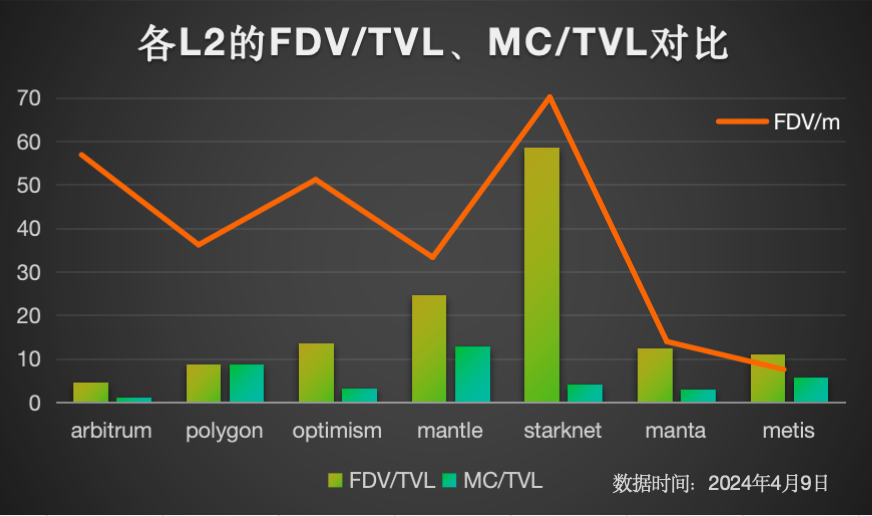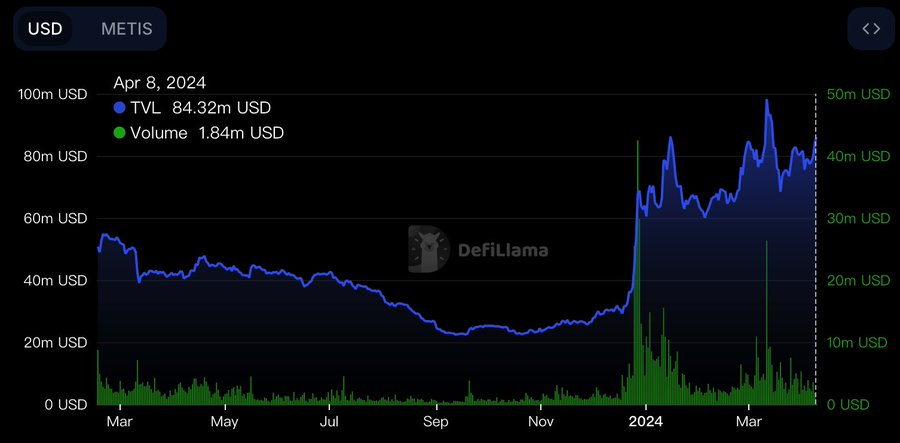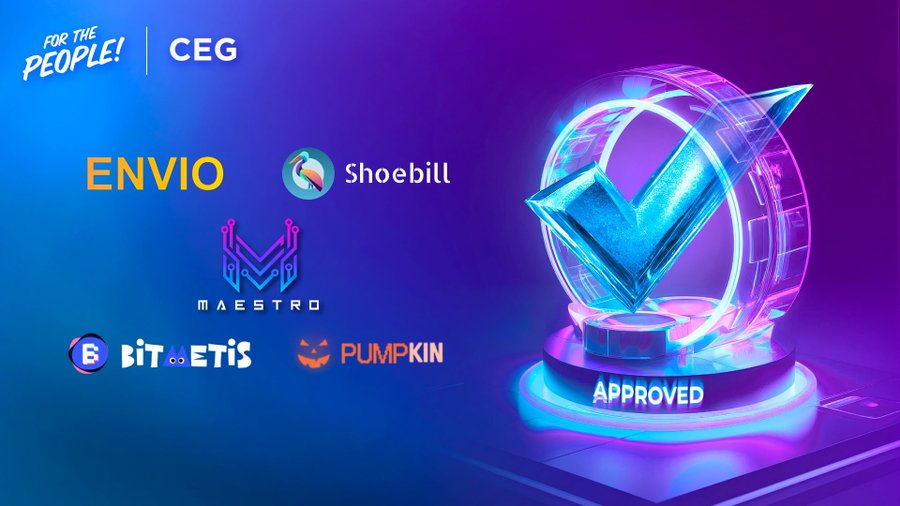The market has just experienced a large-scale sell-off, and the research team has selected Metis from the bottom-fishing targets
The Blob after the Ethereum Dencun upgrade has provided greater development space for L2, while also accelerating the competition in the Layer 2 track. Last week, VanEck published an article predicting the valuation of Ethereum Layer-2 by 2030, analyzing a series of L2 solutions from the perspectives of transaction pricing, developer experience, user experience, trust assumptions, and ecosystem scale.
Based on these factors, VanEck proposed a prediction that by 2030, the total market size of L2 will reach $1 trillion, which opens up the imagination space for the L2 track.
The report emphasizes that although the L2 ecosystem is highly competitive, there is currently no obvious "winner takes all" characteristic. In fact, looking at the data changes of L2 over the past year, it can be observed that the TVL differences among various L2s can easily change in a short period, so the landscape of the L2 track is still undecided.
VanEck also provided five main indicators for evaluating L2 in the report:
- Transaction pricing - The cost for transaction users;
- Developer experience - Ease of building products and applications;
- User experience - Simplicity of deposits, withdrawals, and transactions;
- Trust assumptions - Assumptions of activity and security;
- Ecosystem size - How many interesting things there are to do.
If we apply these indicators to small-cap L2s, can it help us discover potential L2 projects?
First, we filter a target based on the comparison of FDV and MC with TVL: it can be found that Arbitrum, Polygon, Optimism, Manta, and Metis have relatively low FDV/TVL values, and among them, Metis currently has the lowest market cap and the greatest room for growth.
So does Metis have the potential to become a dark horse in L2? We use the five indicators provided by VanEck to make a judgment:
Transaction pricing - In terms of the cost for transaction users, one of Metis's main designs is to optimize data processing and smart contract execution mechanisms, reducing reliance on the Ethereum main chain, which lowers transaction costs and shortens confirmation times; it also supports various revenue models and cost structures, including but not limited to generating income through transaction fees, data compression, and smart contract execution, satisfying the first criterion.
Developer experience - In terms of ease of building products and applications, the platform provides a complete set of security tools and frameworks to help developers build secure DApps, satisfying the second criterion.
User experience - In terms of simplicity of deposits, withdrawals, and transactions, Metis has also put in considerable effort, especially in the rapid access to assets and transaction confirmations, satisfying the third criterion.
Trust assumptions - Activity and security assumptions are explained in VanEck's article as follows: security refers to the properties of the blockchain that ensure only the account owner can access his/her assets, while activity refers to the guarantees that ensure assets can be utilized. It also specifically mentions the concerns of L2 users regarding sequencer failures; currently, most L2s have a single sequencer, which has vulnerabilities. Metis's most prominent advantage is its decentralized sequencer design, which, although slightly lacking in the data availability mentioned by VanEck, still meets this criterion due to its outstanding performance in security.
The last point is the activity and imagination of its on-chain ecosystem. Currently, Metis's overall TVL and volume show strong growth, and Metis has been actively building its ecosystem.
Combining its decentralized sequencer features, the first step for the Metis ecosystem should be to start with staking. A set of gameplay involving LSD, even LSDfi or LRD, could potentially be implemented on Metis.
Recently, many key ecological projects have been successively launched on it, such as the highly popular LSD project @ENKIProtocol, which has garnered attention as the first LSD protocol on Metis, and its token $ENKI has now been launched. (It is recommended to focus on secondary opportunities.)
Another innovative project proposing LPD (Liquidity Position Derivatives), Vector Reserve, has also launched on Metis. Using Vector Reserve's LPD model, users can mint vMETIS from their METIS and METIS LST tokens, not only earning $VEC rewards but also further increasing METIS's yield. vMETIS/METIS can also be placed in HerculesDEX to earn additional rewards.
The proposals for Metis's ecosystem are also very active, accelerating the launch of Metis ecosystem projects through community voting. Currently, over a hundred projects have been launched on Metis through community validation.
It can be seen that through the leverage of circulating staking, it is easy to inflate the TVL bubble. By further connecting liquidity with other blockchain networks through cross-chain interoperability protocols, the asset scale of the network can be increased. Therefore, the ecological development aspect is also promising for the future.
Additionally, VanEck's article also mentions: "While there is reason to believe that some L2 tokens will become valuable, the pathways to value appreciation are harder to predict than in other areas of crypto. Especially since L2 tokens are not even the base currency within their ecosystems." The empowerment of L2 tokens has always been one of the community's greatest concerns, and $METIS has a comparative advantage in value capture over most L2 tokens.
Currently, the progress of Metis's decentralized sequencer is also going smoothly, about to enter the second phase, mainly to achieve: multiple transactions within a block, transaction pools, and sequencer rewards.
In summary, if we look at Metis through the evaluation criteria provided in the VanEck report, it indeed qualifies as a potential project. The most urgent work needed to be carried out, like all public chains, is ecosystem construction. However, from the recent ecological development, Metis seems to have a clear direction and is steadily moving forward.











